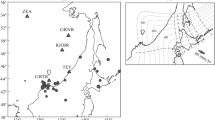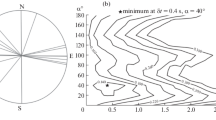Abstract
The seismic anisotropy of the mantle is studied based on the data of S and ScS waves from earthquakes occurred in the mantle transition zone over the period of 2007–2013 and recorded by seismic stations in the continental margin of Asia, on Sakhalin Island, and in the southern part of the Kamchatka Peninsula. The measurements of the azimuths of polarization of the fast S and ScS waves in the continental margin of Asia show that they are predominantly oriented in the E–SE directions. Based on the distribution of the shear wave splitting parameters, the symmetry of the medium can be described in terms of a transversely isotropic model with a horizontal symmetry axis and may correspond to horizontal flow in the upper mantle beneath the Amur Plate. The fast azimuths of polarization of ScS wave, which were determined to be of N–NE directions in the northern area of Sakhalin Island and in the continental part of Asia, may correspond to an inclined flow under the conditions of oblique subduction and complex geometry of the downgoing Pacific Plate. In the south of the Kamchatka Peninsula, the S- and ScS-wave azimuths of polarization from the M 8.4 Sea of Okhotsk earthquake are determined to be oriented along the direction of the Pacific Plate motion. The fast-S-wave azimuths of polarization from the aftershocks of the Sea of Okhotsk earthquake and from other large events of 2008–2009 are determined to be nearly parallel to the motion trend of the Pacific Plate, but orthogonal to it for the events of 2008–2009. On the basis of the distribution of azimuths of polarization of the fast S waves, the symmetry of the medium can be described in terms of a transversely isotropic model with the symmetry axis inclined orthogonally to the plane of downgoing plate and oriented westward orthogonally to the trench strike.
Similar content being viewed by others
References
M. N. Luneva and D. M. Li, “Anisotropy and temporal variations in the fast azimuth of the fast shear wave beneath southern Kamchatka during 1993–2002,” Izv., Phys. Solid Earth, 42, 307–322 (2006).
M. N. Luneva and V. V. Pupatenko, “Splitting of ScS and S waves from the Mw 8.4 Okhotsk deep-focus earthquake (May 24, 2013) and its strong aftershocks,” Russ. J. Pac. Geol. 8, 456–463 (2014).
J. R. Bowman and M. Ando, “Shear-wave splitting in the upper-mantle wedge above the Tonga subduction zone,” Geophys. J. RAS 88, 25–41 (1987).
C. P. Conrad, M. D. Behn, and P. G. Silver, “Global mantle flow and the development of seismic anisotropy: differences between the oceanic and continental upper mantle,” J. Geophys. Res. 112, B07317 (2007). doi 10.1029/2006JB004608
H. P. Crotwell, T. J. Owens, and J. Ritsema, “The TauP toolkit: flexible seismic travel-time and raypath utilities,” Seismol. Res. Lett. 70, 154–170 (1999).
M. Faccenda, “Water in the slab: a trilogy,” Tectonophysic 614, 1–30 (2014).
M. Faccenda, “Mid-mantle seismic anisotropy around subduction zones,” Phys. Earth Planet. Inter. 227, 1–19 (2014).
K. M. Fischer, M. J. Fouch, D. A. Wiens, and M. S. Boettcher, “Anisotrophy and flow in pacific subduction zone back-arcs,” Pure Appl. Geophys 151, 463–475 (1998).
M. J. Fouch and K. M. Fischer, “Mantle anisotropy beneath Northwest Pacific Plate,” J. Geophys. Res. 101 (B7), 15987–16002 (1996).
B. K. Holtzman, D. L. Kohlestedt, M. E. Zimmerman, et al., “Melt segregation and strain partitioning: implications for seismic anisotropy and mantle flow,” Science 301, 1227–1230 (2003).
G. Jiant, D. Zhao, and G. Zhang, “Detection of metastable olivine wedge in the Western Pacific slab and its geodynamic implications,” Phys. Earth Planet. Inter. 238, 1–7 (2015).
E. Kaminski and N. M. Ribe, “A kinematic model for recrystallization and texture development in olivine polycrystals,” Earth Planet. Sci. Lett. 89, 253–267 (2001).
E. Kaminski and N. M. Ribe, “Time scales for the evolution of seismic anisotropy in mantle flow,” Geochem., Geophys., Geosyst. 3 (1), (2002). doi 10.1026/2001GC000222
S. Karato, H. Jung, I. Katayama, and P. Skemer, “Geodynamic significance of seismic anisotropy of the upper mantle: new insight from laboratory study,” Ann. Rev. Earth Planet. Sci. 36, 59–95 (2008).
B. L. N. Kennett and F. R. Engdahl, “Traveltimes for global earthquake location and phase identification,” Geophys. J. Int. 105, 429–465 (1991).
E. A. Konstantinovskaya, “Arc-continent collision and subduction reversal in the Cenozoic evolution of the Northwest Pacific: an example from Kamchatka (NE Russia),” Tectonophysics 333, 75–94 (2001). doi 10. 1016/S0040-1951(00)00268-710.1016/S0040-1951(00) 00268-7
V. Levin, D. Droznin, J. Park, and E. Gordeev, “Detailed mapping of seismic anisotropy with local shear waves in southeastern Kamchatka,” Geophys. J. Int. 158, 1009–1023 (2004).
K. D. Litasov, A. Shatskiy, and E. Ohtani, “Melting and subsolidus phase relations in peridotite and eclogite systems with reduced C–O–H fluid at 3–16 GPa,” Earth Planet. Sci. Lett. 391, 87–99 (2014).
K. H. Liu and S. S. Gao, “Making reliable shear-wave splitting measurements,” Bull. Seismol. Soc. Am. 103 (5), 2680–2693 (2013). doi 10.1785/0120120355
M. D. Long and T. W. Becker, “Mantle dynamics and seismic anisotropy,” Earth Planet. Sci. Lett. 297, 341–354 (2010).
M. D. Long and E. A. Wirth, “Mantle flow in subduction systems: the mantle wedge flow field and implications for wedge processes,” J. Geophys. Res.: Solid Earth 118 (2013). doi 10.1002/jgrb.50063
M. N. Luneva and J. M. Lee, “Shear wave splitting beneath south Kamchatka during 3-year period associated with the 1997 Kronotsky earthquake,” Tectonophysics 374, 135–161 (2003).
J. Park, V. Levin, J. Lees, M. T. Brandon, V. Peyton, E. Gordeev, and A. Ozerov, “A dangling slab, amplified arc volcanism mantle flow and seismic anisotropy near the Kamchatka plate corner,” in Plate Boundary Zones, Ed. by S. Stein and J. Freymueller (Am. Geol. Union, Washington, 2002), pp. 295–324.
V. Peyton, V. Levin, J. Park, M. T. Brandon, J. Lees, E. Gordeev, and A. Ozerov, “Mantle flow at a slab edge: seismic anisotropy in the Kamchatka region,” Geophys. Rev. Lett. 28, 379–382 (2001).
E. Sandvol and T. Hearn, “Bootstrapping shear-wave splitting errors,” Bull. Seismol. Soc. 84, 1971–1977 (1994).
W. P. Schellart, M. W. Jessell, and G. S. Lister, “Asymmetric deformation in the backarc region of the Kuril Arc, Northwest Pacific: new insights from analogue modeling,” Tectonics 22, 1047–1063 (2003). doi 10.1029/2002TC001473
W. P. Schellart, D. R. Stegman, and J. Freeman, “Global trench migration velocities and slab migration induced upper mantle volume fluxes: constraints to find an earth reference frame based on minimizing viscous dissipation,” Earth-Sci. Rev. 88, 118–144 (2008).
W. P. Schellart, D. R. Stegman, R. J. Farrington, and L. Moresi, “Influence of lateral slab edge distance on plate velocity, trench velocity, and subduction partitioning,” J. Geophys. Res. 116, B10408 (2011). doi 10.1029/2011JB008535
W. P. Schellart and L. Moresi, “A new driving mechanism for back-arc extension and backarc shortening through slab sinking induced toroidal and poloidal mantle flow: results from dynamic subduction models with an overriding plate,” J. Geophys. Res.: Solid Earth 118, 3221–3248 (2013). doi 10.1002/jgrb.50173
P. Solver and W. Chan, “Shear wave splitting and subcontinental mantle deformation,” J. Geophys. Res. 96 (10), 16429–16454 (1991).
L. Vecsey, J. Plomerova, and V. Babushka, “Shearwave splitting measurements: problems and solutions,” Tectonophysic 462, 178–196 (2008).
W. Wei, D. Zhao, J. Xu, F. Wei, G. Liu, “P and S wave tomography and anisotropy in Northwest Pacific and East Asia: constraints on stagnant slab and intraplate volcanism,” J. Geophys. Res.: Solid Earth 120, 1642–1666 (2015). doi 10.1002/2014JB011254
E. Wirth and M. D. Long, “Frequency-dependent shear wave splitting beneath the Japan and Izu-Bonin subduction zones,” Phys. Earth Planet. Inter. 181, 141–154 (2010).
A. Wüstefeld, G. Bokelmann, C. Zaroli, and G. Barruol, “Splitlab: A shear-wave splitting environment in Matlab,” Comput. Geosci. 34, 515–528 (2008). doi 10.1016/jcageo.2007.08.002
Z. Znan, H. Kanamori, V. C. Tsai, D. V. Helmberger, S. Wei, “Rupture complexity of the 1994 Bolivia and 2013 Sea of Okhotsk deep earthquakes,” Earth Planet. Sci. Lett. 385, 89–96 (2014).
Author information
Authors and Affiliations
Corresponding author
Additional information
Original Russian Text © M.N. Luneva, V.V. Pupatenko, 2016, published in Tikhookeanskaya Geologiya, 2016, Vol. 35, No. 4, pp. 40–48.
Rights and permissions
About this article
Cite this article
Luneva, M.N., Pupatenko, V.V. Seismic anisotropy of the mantle beneath Eastern Asia based on ScS and S waves from deep-focus earthquakes. Russ. J. of Pac. Geol. 10, 274–282 (2016). https://doi.org/10.1134/S1819714016040059
Received:
Published:
Issue Date:
DOI: https://doi.org/10.1134/S1819714016040059




